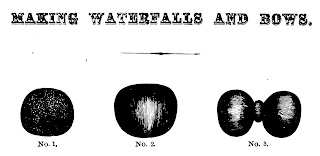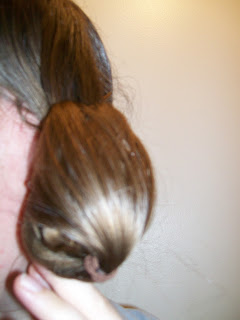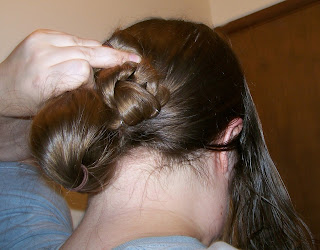| "Woman Combing Her Hair" by Rosetti, 1864 |
"There was found a mass of hair covered by a net, and known among the ladies, and the 'initiated' as a 'water-fall'. A mischievous young man having secured the prize, was trying to match the stray ornament to the hair of the various young ladies in the room. Strange to say the owner could not be found, though the affair caused no little merriment."
-"The Inconvenience of Modern Fashion", Arthur's Home Magazine, 1865
"The Hair for morning costume should be very plain. The elaborate way of arranging it, now so fashionable, is only suited to a very dressy toilet. A large knot of hair, a bow or waterfall, is still the mode of dressing it at the back with frizettes, loops, and bunches of curls in front."
-Peterson's, November 1864
For this post, I'll be taking a closer look at waterfalls, and attempting to make one.
 |
| L to R: Hair cushion, waterfall, bow from "The Self-Instructor in Hairwork", 1867 |
The earliest reference I've found to the waterfall hairstyle is in Godey's, 1863: a short description* in the May novelties, and an image in July's.
 |
| "Coiffure arrange in looped bands in front and a waterfall in back" |
 |
| Waterfall Chignon, Frank Leslie's, 1865 |
The amount of hair in most of these styles is distinctly increasing. Although some descriptions still speak of 'forming the back hair into a waterfall', by 1866 Godey's openly mentions purchasing such hair arrangements: "The coil which we spoke of last month will eventually dethrone the waterfall. Very pretty ones can be bought ready made to pin on the head."
Let's get to work. I'm going to try this using my own hair, resorted to strategically placed padding if needed. The goal is a basic waterfall, like so:
 |
| "Waterfall Coiffure", Godey's 1863 |
Though, considering the volumes invovled, the back may end up looking more like this:
 |
| "The Empire Coiffure", Godey's 1866 |
1. Start with the usual T-part from the basics post. This won't be universal for all waterfalls, but it'll do for this one.
2. Tie off the back hair in three places, forming a low ponytail with two bunches below the scalp, and a tail hanging free. In the original reference I once saw (and now have been unable to locate, and really hope I wasn't just imagining), this was done with string that could be tied together at a later stage. Needing a hand free for the camera, I opted to use hair-colored rubber bands.
3. Because I have a ton of excess hair at the bottom of the pony tail, I wound it up on itself to use as a "cushion", in lieu of adding more hair. In my case, it worked best to braid the hair below the third band, then coil it up on itself.
4. Folded the hair up at the second band, so that bunch 1 is closest to the neck, bunch 2 is on the outside, and the braided/coiled tail is between them.
5. Pin the tail section to the back of the head, then fan bunch 2 out over the whole shebang.
6. Arrange the side hair in your favorite style, then tuck the loose ends beneath the waterfall. I opted for simple rolls.
In case my pictures are hard to follow, I repeated the process with side hair, so that it's more in focus. [I've seen no references to waterfalls worn on the side, so please don't copy this as a style.]
 |
| Hair sectioned and (optional) tail braided |
 |
| "Tail" hair coiled together. |
 |
| Second bunch folded up over the first, with the coiled tail in between. |
 |
| Coil pinned in place and outer hair smoothed over. |
And that's a basic waterfall. The method is not explicitly period--I've found no (more) references for making a single waterfall using one's one hair, as opposed to weaving and sewing loose hair into shape--but it's plausible, makes the style, and uses period materials, save for the hair-ties. I'll use ribbon or string when wearing it for real.
To end on a light note, given the way Punch is trusted on crinoline size, I'm just waiting for someone to take this cartoon seriously:
*Apparently, in 1863, 'frizettes' (hair pads) are being called "rats" if used for side hair, "mice" if very small, "cats" if placed on top of the head, and "cataracts" if used at the back of the head for a "waterfall".
To end on a light note, given the way Punch is trusted on crinoline size, I'm just waiting for someone to take this cartoon seriously:
 |
| "What to do with a Waterfall", Frank Leslie's, 1865 |





I came upon this explanation while researching the meaning of Mark Twain’s words “wearing whiskers or waterfalls” (describing the changed state of the children he knew from his youth) in the book “Roughing It”. Thank you for your explanation of what “waterfall” means in this context!
ReplyDelete